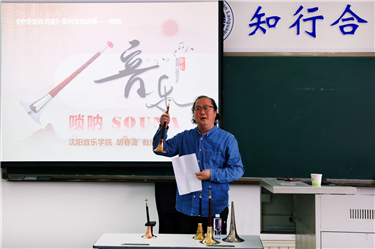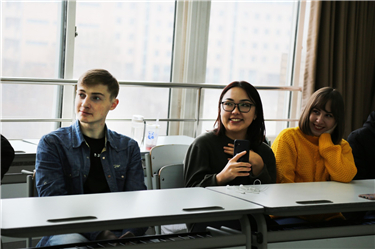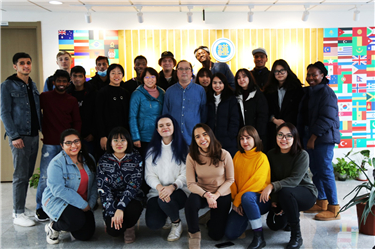The Chinese Academy holds the "Chinese Cultural Bookshelf" Intangible Cultural Heritage Suona Art Salon
Suona is a folk wind instrument with a long history, wide spread, rich skills and strong expressive power in China. Its sound is cheerful and dynamical, high-pitched and loud, with softness in rigidity, and rigidity in softness. It is loved and welcomed by the majority of people, and it is on in the first list of national intangible cultural heritage in China.



In order to further enhance international students’understanding of this traditional folk musical instrument, on December 9th, with the strong support of the Propaganda Department of the Provincial Party Committee, through the "Chinese Cultural Bookshelf" project, Chinese Academy invited Suona performer Hu Chunbo who teaches national first-level performers in Shenyang Conservatory of Music to bring a wonderful Suona Art Salon to international students.
Professor Hu first introduced the evolution and development process and classic style of Suona to the international students present. During the explanation process, he played different pieces of suona works to let the students understand and analyze the timbre characteristics of suona in different regions: Xinjiang suona is cheerful and soft, northeast suona is hot and unrestrained, Shandong suona is soft and beautiful... After understanding of the beauty of the melody of Suona, Professor Hu played three famous suona works for everyone: "A Hundred Birds Face the Phoenix", "A Jujube" and "Guanzhong Qing".
A tune of "A Hundred Birds Face the Phoenix", which presents the artistic conception of all birds singing and singing, takes the listener into the vibrant "Birds Singing Forest", where there are singing and dancing, birds and flowers, and the music presents the listener a vigorous scene of nature. "Da Zao" is a humorous and humorous suona piece, the tune is alive and cheerful, the suona imitation of human sound in Chinese plays and the big and small suona in the music alternately play, like a humorous dialogue between a man and a woman, an old and a young, showing the uniqueness of the Hebei style of playing style; the work "Guanzhongqing" expresses sad memories with a soothing and low melody in the early part, and the middle rhythm gradually accelerates, symbolizing the praise of today's good life, and the final climax shows the emotion of looking forward to a better future. The ups and downs of the tune make the listeners feel the joys and sorrows of the people in Guanzhong and the reincarnation of fate.
Professor Hu's wonderful explanation and vivid and exquisite playing skills deeply impressted the international students present, and everyone expressed their feelings. The "Chinese Cultural Bookshelf" Intangible Cultural Heritage Suona Art Salon has allowed international students to vividly and intuitively learn and experience the charm of Chinese excellent traditional folk music and art.
